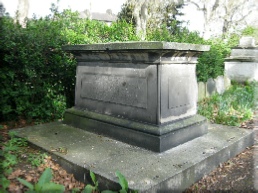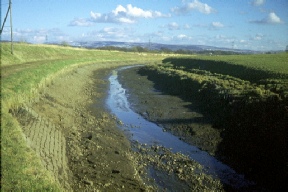When London Became An Island
Hugh McIntosh 1768 -1840
Hugh McIntosh was born in the hamlet of Milltown of Kildrummie (alternative spelling Kildrummy) near the Scottish town of Nairn in 1768. It was a time when memories of the Jacobite rising of ‘45 may have seemed fresh in the mind of his father’s generation and many of his grandfather’s generation could have recalled the events of ‘15 as vividly. But defeat at Culloden coupled with the continuing military road building and pacification programmes, not to mention the development of sheep farming, meant the end of the old ways of life in that part of Britain. To a bright and ambitious young man from a fairly humble background the prospects of a making a good living must have seemed poor and getting poorer. For McIntosh the way out was through education and then, as important, the development of a sound reputation in a difficult field.
Young Hugh apparently attended Inverness grammar school, housed in what is now the Dunbar Centre. The grammar school may well have moved away from a purely classics based curriculum by the late C18th and it is certainly true emphasis was placed on science and mathematics in a new academy, which superseded the old school in 1792. How in tune the new institution was with the spirit of the times was reflected in the fact that one of the early rectors, Alexander Nimmo, went on to become an important civil engineer in the development of the Irish infrastructure.
It is uncertain how long McIntosh remained at school, but he evidently began work on canals as a navvy on the Forth and Clyde. This was completed in 1790 with funds from the forfeited estates of those who had supported ‘Bonnie Prince Charlie’. Once the Forth and Clyde was completed McIntosh crossed the border to make his living in the north of England, on the Lancaster Canal. Quite why McIntosh went to that line is unclear as this was the heyday of canal construction and there were many projects to choose from. Perhaps it was because the Lancaster was relatively close to the Scottish border or maybe McIntosh had observed the work of Robert Whitworth, a leading canal engineer of the time, on the Forth and Clyde. Whitworth was involved with the Lancaster Canal in its planning stage and became engineer of the Leeds and Liverpool Canal. Digging on the Leeds and Liverpool and Lancaster canals was quite close in some parts and it was intended there would eventually be a junction between them. Whatever the reason it was on the Lancaster that McIntosh became a contractor in his own right.
In the early 1790s most engineers preferred to put construction of the canal for which they were responsible in the hands of many small contractors, but on the Lancaster the well known partnership of Pinkerton and Murray were employed, at least at first. However, Pinkerton and Murray proved to be so disorganised and unreliable that the Chief Engineer, John Rennie, wrote to the company secretary to commiserate saying I am not surprised at your being out of patience with P and M. I think it would be hard business for Job himself. Eventually, in 1795, P and M were sacked and it may have been this change which gave McIntosh an opportunity to undertake small scale contracting in his own name.
The dismissal of Pinkerton and Murray would have found favour with Archibald Millar, resident engineer, for, in his opinion, small contractors were easier to manage. ‘No fine Law contracts’ he said,’ are necessary on such occasions. If a man does not behave as he ought drum him off.’ This was all well and good, but supervision was time consuming and confrontation with a difficult contractor could be draining. Take John Parkin, a contractor on the Leeds and Liverpool. Whitworth was to write that Parkin was …a conceited, Ignorant old man that would not be guided… and one can imagine the arguments which preceded this report. However, in such a situation any small contractor who proved himself to be steady and reliable over a long period would naturally find favour with an engineer and it appears that McIntosh soon gained such standing. In 1796 there were 35 small contractors at work on the Lancaster and McIntosh was probably one of those. Acquisition of capital to enlarge his little enterprise probably meant any income generated was saved and there certainly seems little sign of extravagance when McIntosh married. What his bride, Mary Cross, was to make of the first marital home is not recorded. It was, evidently, furnished with bedding of straw, had an earth floor and was built from stone excavated for canal works. But she would not have to tolerate such poor conditions for long.
The McIntosh family tomb in the grounds of St Matthias Community Centre, Poplar. Hugh McIntosh’s brother, James, who was involved in the business, married his wife’s sister.
Click the back button to return to the main text
This photograph of the Lancaster Canal, which had been drained for repair work, was taken in 1979. McIntosh took the first excavation contracts in his own name on this canal in the 1790s.
McIntosh met Rennie when working on the Lancaster. Like McIntosh, Rennie was a Scot with an agricultural background. They were fairly close in terms of age (Rennie was the eldest by seven years) and their relationship was to be important in the development of McIntosh’s career. Rennie knew just how crucial a reliable contractor was and when given responsibility for major new engineering works in London, it is not surprising McIntosh followed him to the capital. In 1803, the contractor took up residence in Poplar, very close to the site of the East India Docks. He could hardly have been closer to his work and Mrs McIntosh now found herself in a proper house but, unfortunately, the Royal Navy, Britain’s main defence in the war against Napoleon, was on the look out for the kind of fit, strong men that McIntosh wanted to employ. Construction on the docks had hardly started before it stopped and it did not recommence until assurances were given that the press gang would leave the diggers alone.
McIntosh’s work on the Isle of Dogs enhanced his reputation. It eventually came to the attention of the government and evidently led to his being invited, rather than press ganged, to join a force being sent to the island of Walcheren in 1809. The objective was strike at Napoleon’s fleet and destroy the fortifications at Flushing. McIntosh would evidently have been responsible for overseeing demolition of these fortifications, but the whole expedition turned into a disaster and thousands of soldiers succumbed to a combination of malaria, typhus, typhoid and dysentery.
McIntosh escaped the ravages of what became known as Walcheren fever and continued to make money as a constructor rather than a demolisher. He encouraged his family to enter the business, invested in buying land, branched out as a developer in his own right and built up the area around Mile End. His son, David, went off to university in Glasgow to study civil engineering. David’s early education had been at Mr Stock’s School (which would have been the Poplar House Academy in Poplar Street as Poplar High Street was then known) but it would appear McIntosh took the same attitude to an education at an English university as John Rennie. Rennie’s son, also called John, became a famous civil engineer in his own right. According to John Rennie junior the view of John Rennie senior was after three or four years at the University of Oxford or Cambridge, he cannot, without much difficulty, turn himself to the practical part of civil engineering.
When contracts for diggings on the Regents Canal were offered in 1812 McIntosh tendered and his applications indicate the confidence of a shrewd businessman who knew just how to price work for a profit. Whenever he accepted a contract McIntosh made it clear he would meet all the terms, but expected those with whom he signed an agreement to meet their obligations too. If they did not McIntosh was quite prepared to go to court. He became known for being a litigious person and in those difficult financial times he probably needed to be. His relationship with the Regents Canal company was, on the whole, good, but he threatened legal action in 1818 when he considered the company was reneging on an agreement made for excavation in St Pancras. Under this pressure, and after looking closely at their own case, the company conceded, something that probably would not have happened if McIntosh had been weak and vacillating.
The Regents Canal was not the only major work McIntosh undertook in London at the time as, after 1815, he was also contracted to work on the Commercial Docks and by 1820 he had become the principal contractor for public works in England. In all he undertook over 120 contracts in his lifetime, far more than any of his contemporaries, and these included the British Museum, Hampton Court and Brighton Pavilion.
Why was McIntosh so successful? Well perhaps John Nash gave the best insight when responsible for the refurbishment of Buckingham Palace. The Prince Regent’s favourite architect ensured the work was not put out to tender because, in his view, McIntosh would be the best person to take the contract due to his known probity and great means of performing the works. In other words McIntosh was an upright and honest man who had sufficient capital, plant and equipment to see the job through to the end. A similar confidence was shown by Thomas Telford who decided to abandon the principle of competitive tendering when charged with ensuring the Gloucester Docks and Sharpness Canal were completed. With the support of the Exchequer Bill Loan Commissioners (who had posed such a threat to the shareholders of the Regents Canal) Telford offered the contract directly to McIntosh.
In 1821 McIntosh moved the base of his operations to Bloomsbury and his offices were only a few yards away from the Percy Coffee shop where the meeting that initiated the Regents Canal was held. However, he maintained links with Poplar and continued to work on the local transport infrastructure. The Regents may have been the last major canal to built in England, but the London to Greenwich was one of the first railways and McIntosh had a hand in both. In 1837, three years before his death, the Gentleman’s Magazine carried a celebratory article, which said,
This great national work reflects the highest honour on the gallant proprietor, Colonel Landmann, no less credit on the contractor, Mr Macintosh, under whose orders no less than 60,000,000 bricks have been laid by human hands since the Royal assent was given to the Act of Parliament for its formation in 1833.
Hugh McIntosh died in 1840 aged 72. He was the kind of man that Samuel Smiles could well have taken as a model for his inspirational book ‘Self Help’. Smiles was a good deal younger than McIntosh but was secretary of the South East Railway, which leased the London and Greenwich Railway after 1845. He must, surely, have given a thought to contractor, who like himself and Rennie, was a Scot of humble origins, as he rattled in to London Bridge Station on the long, straight viaduct that was the first incursion by a railway into any capital city in the world.


